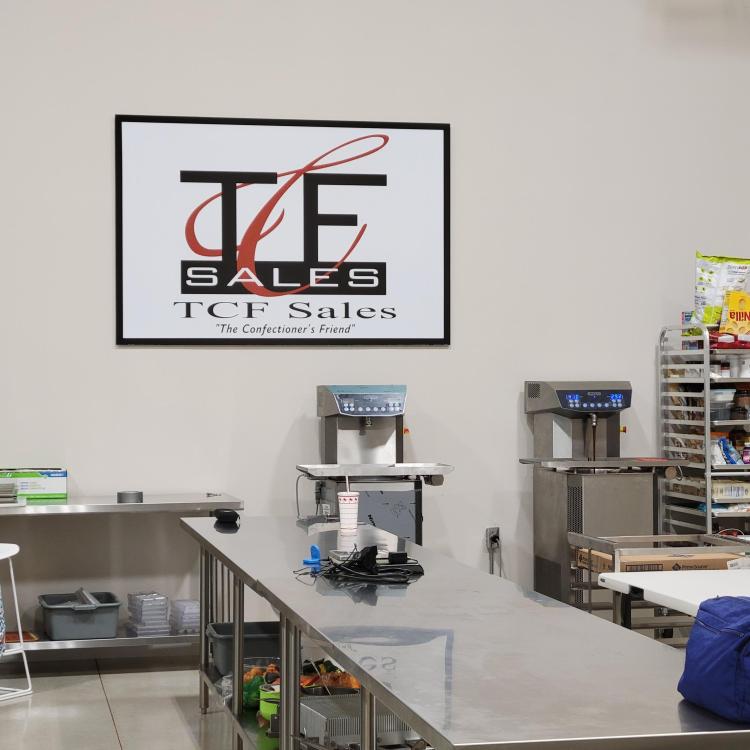Search the Community
Showing results for tags 'Chocolate'.
-
HelloS I began making bonbons a year ago and use AUI to order the chocolate and fruit purées. Have had great success with Des Alpes Coins using the 63% Dark Garnet, the 37% Milk Topaz, and the White Opal. But I do not see any recommendations for Des Alpes in my (hopefully) thorough search on this forum. Felchin gets high marks frequently. But so many to choose: Any recommendations? I see Sao Palme, Opus, and Elvesia- and others. (I’m still using just coins- haven’t graduated beyond that yet) Many Thanks.
-
People are starting to arrive in Texas! @Chocolot @Kerry Beal @Alleguede and many others arrived earlier this week and have been preparing for the workshop!
-
I am making molded bunnies for Easter and I am finding that the necks are cracking and the head breaks away from the body. I have noticed that the neck is not as thick as the rest of the bunny. Total grams for this bunny is 200. Does anyone have any suggestions on how to rectify this? Oh yeah I didn't mention that after pouring into molds I place in the refridgerator. Any suggestions are welcome! Cheers Mary - Rookie
-
I sell bonbons to shops that keep them at room temp and put a best by date of 8 weeks after they leave refrigeration, otherwise I keep them cold. I'm not 100% sure they're as good after 2 months at room temp but I do it anyway. (I've done some aW testing of the recipes but I don't test each individual batch) Today I went in to fill an order and my bonbon fridge had died sometime after yesterday afternoon, was blowing warm air and displaying 76F. Nothing was melted but definitely warm. so, would you: A) sell that product as usual, it's just warm room temp, no worse than summer B) sell but with a closer 'best by' date C) panic and throw everything in the compost
-
As a lot of you already know, Kerry Beal has been working on a device to help the artisan chocolate maker – the EZtemper. I got a chance to see the EZtemper in action this weekend at the eGullet Chocolate and Confection 2015 workshop and it was nothing short of amazing. Dead simple to operate, you basically just load a container with cocoa butter and turn it on. Allow it to work overnight (about 12 hours, I think) and the EZtemper will produce cocoa butter silk i.e. Form V Beta crystals. The cocoa butter is transformed into a mayonnaise-like consistency which can then be used to instantly temper any melted chocolate or ganache. Like Mycryo, you add 1% by weight to melted chocolate at the proper temperature; however, the chocolate silk produced by the EZtemper is superior, in my opinion, because you don’t have to worry about melting out the Mycryo cocoa butter crystals and incorporating it into the melted chocolate. You just have to stir the silk in – much more easy. Not only that, but you can use it to temper your ganaches which we all know produces a product with longer shelf life and better mouthfeel. As if that weren’t enough, it also causes your ganache to set up much much faster. So you can pour out a slab of tempered ganache and move to cutting and enrobing a short while later. I think this device is going to revolutionize the chocolate industry. You should consider it for your confectionery business if you want to save a lot of time and produce a superior product. Take a look at the web site here: http://www.eztemper.com
-
Has anyone successfully recreated the cream inside a raffaello truffle?? There are a lot of recipes on the internet but those don't achieve the same texture as the real raffaello cream ; _ ; Any advices/experiences/ideas are appreciated :))
-
One of the dishes at Alinea this weekend was a shot that included green apple juice or cider inside of a cocoa butter orb dusted with horseradish set in celery juice. The orb was crisp and thin. I've never worked with pure cocoa butter...can you temper it by itself? I didn't taste the sweetness of white chocolate, nor was it billed as white chocolate.
-
Tempering machine Selmi, Pomati, ChocolateWorld, Kadzama,...
Vojta posted a topic in Pastry & Baking
Hello What continuous tempering machine should I buy? It is very difficult to find non biased info. Sales persons just dont know. And I dont know chocolatiers who had experience with multiple machines (and can fairly compare)... Personally I worked with Selmi and Pomati, here are my findings. Pomati big plus for ease of emptying with an emptying spout + reverse pumping function (also prevents chocolate to harden inside). Small pluses, I guess: Night mode can be set with active agitation intervals. You can set the cooling point temperature by yourself (for example 26, 27 °C On the other hand with Selmi you cant set it neither see it). Big minus: Scraper is not heated (enough) and can not be attached under an angle. Frustrating minus: Touch display is a step back Minus (that Selmi might suffer from too?): when I left moulds on the heated vibrating plate for a long time, it melted the chocolate. The whole table gets heated, not just the metal bars. Selmi lacks everything said about Pomati above. Howeve has heated adjustable scraper, buttons. Newer Selmis have removable and washable Archimedes screw. Didn't try it, not sure if it's any useful. I don't have enough experience to value my findings in the long run and would appreciate a little discussion. Also can not compare the longevity, tempering quality etc. In my chocolate bubble everyone uses Selmi though. Bonus Q: for what capacity should I go? 20-30 kg or larger? -
I have a Revolation X temperer and am anxious to try using cocoa butter silk for tempering. I've asked around but so far haven't found anyone who has done it. Called the manufacturer and they gave me a reference, but it didn't pan out: the fellow didn't respond to my inquiry. Has anyone here done it, and/or has any advice for me?
-
Hi guys. Came across these amazing bon bons on Instagram. How would you say I could replicate the design? thabks.
-
Is this an enrobed piece that these are displayed on, or is there a magnetic mold this shape? One or more of you experts must know. Thanks in advance! https://shop.chefrubber.com/item/901374S/12-Days-Of-Christmas/
-
I wanted to produce a chocolate that has two layers of color, with bronze powder on top and some green color sprinkled underneath. The mould was half-circled shape. First of all I polished the chocolate mould, then I tempered the colored cocoa butter to 96-97F, then sprayed it inside the mould using an airbrush. then I used a small knife to tip up a little shiny bronze powder and sprinkled it in the mould. I waited for about an hour or two, then I poured chocolate into the mould. After I released the chocolate from the mould, there were some cocoa butter sticking to the mould, causing the surface of my chocolate to crack. There were also some shiny bronze powder stuck to the the cocoa butter inside the mould, causing the surface of my chocolate to have big holes on the area where there should be full of shiny powder. I have tried not to use any shiny bronze powder and only finger painted the mould with the colored cocoa butter, as the result there was no problem at all and there were no colored cocoa butter sticking to the mould. The mould was bought from Chololat-Chocolat, the colored cocoa butter was from Chef Rubber, and the shiny bronze powder was from PCB. Did I do anything wrong throughout the process? Exactly why did my finished products resulted in this way?
-
Hi folks, long time lurker here. I was wondering if anyone had any ideas on how I can produce a filling for my bonbons that is fresh cream or milk flavoured? I've tried a couple of experiments using white chocolate or coconut oil meltaway style bases but it always just ends up tasting like white chocolate and not the more distinctly dairy flavour I'm hoping for. I considered fondant but I'm worried at how sweet it will be. I'd love to find a relatively neutral base to use for this sort of flavour but my google-fu has failed me on this occasion and I just end up overrun with results for ganache that contain the word "milk" or "cream" which is...a lot. For context this is to use for flavours like latte, trifle, tiramisu etc Hopefully someone has come across something suitable before 🤞
-
Hello Fellow Chocolatiers! I am working on calculated appropriate prices for my handmade chocolates. It's absolutely shocking that after 10 years of making chocolates, I never really dared to delve into the nitty-gritty cost of goods. And when I worked at a chocolate shop that was never a concern placed on my plate. So, I have attemped (with my horrible lack of excel spreadsheet skills) to figure out my cost of goods (including labor and packaging). Somehow, I must be doing something terribly wrong, as my costs worked out to be about $1.50 to make ONE PIECE. That seems outrageous! Granted, that did include using locally made bean-to-bar chocolate from a small producer. My business-partner-to-be is helping me sort it out (thankful that she and excel have a much better relationship). However, I need some information that is don't have at the moment and thought you guys might be able to help fill in the gaps. 1. For the sake of comparison, with cost of ingredients and labour (no packaging) how much does is cost you to produce one chocolate? 2. For those that make the fairly standard 22.5mm square enrobed chocolates, are you able to tell me how much and individual ganache square weighs pre-enrobing? How about post-enrobing? I know how much my ganache cost, but I don't know how many grams per piece to allot for the enrobed chocolate coating. And I am not in production right now so I can't test it out. If you can share it would be so helpful. ETA: can anyone tell me the same for one of their molded chocolates? Obviously there are variables like the height of the ganache and the size of the mould, but at least it would give me an idea. many thanks! Christy
-
Hi folks! I've recently dabbled in running some kid bon-bon making birthday parties and they've been really fun (would NOT recommend for under 12 though:) I'm trying to cut time by tempering the chocolate in advance (pre-party) and then keeping it at 32 in the melter. It's usually a good 45 minutes before the shelling happens, so by that point, the chocolate is incredibly over-crystalized. I'm trying to streamline this process a bit, and so far all I've come up with is about 5-10 minutes before shelling, adding some untempered melted chocolate at working temp. But I'm just wondering if anyone has any other suggestions for doing advance tempering, without having to futz with it until its ready to be used. Thank you! Jen
-
I've been making chocolates in my spare time over the past few years, but have taken a few big steps lately towards shifting from pastry chef to chocolatier. I had packaging designed and made, cobbled together a website, rented space in a commissary kitchen, and am almost out the door at the restaurant. Yup, finally quit the day job! I've done two pop-up shops and will be part of another on Saturday, and today I exhibited and sold at the Seattle Luxury Chocolate Salon. I'm learning a lot, but one thing I still need to figure out is how to determine shelf life and balance that with production. Products are filled bonbons, ganache truffle squares, bars with fillings or inclusions, caramels, and pate de fruits. My estimate of shelf life is around 2 weeks for bonbons and pdf, 3-4 weeks for truffles, and longer for caramels and bars. I guess I don't have a specific question, more looking for insight on how other confectioners & chocolatiers manage to have efficient production. Do you date your product? Refrigerate/freeze it? How do you determine your sell by date? How many orders/boxes of an item do you usually make at once, and how long does it take to sell? How much of a window before the sell by date do you think people expect? Is it better to have an earlier sell by date and risk people thinking it might be bad when it probably isn't, or have a later date and risk people waiting too long and eating things not at their peak? Your thoughts & experience are appreciated! Andrea
-
I live in a household of beer snobs - craft beer snobs to be precise. So there's been some pressure here for me to create beer chocolates. I completed experiment #1 yesterday and want to share for feedback and / or thoughts. I based my ganache recipe off how you'd do a fruit puree-based ganache. However, instead of adding a fruit puree, I created a "liquid" beer gel from a liquid port gel recipe I found on a molecular cooking site. Simply, this combined beer and agar agar. The gel was cooled and then pureed with an immersion blender. I had to add about twice as much beer as the recipe called for because upon pureeing, the gel broke into teensy tiny little balls of gelified beer. Not good. I had to heat/reheat and keep blending and adding beer until I got a more or less pudding like beer gel. Not terribly scientific, but the beer retained most of its flavor (I used a Founders barrel aged ale - so very strong and flavorul beer to start with). I added the beer gel to a ganache that had cream and butter and a 38% milk chocolate base. The ganache recipe I was working from also calle for glucose and invert sugar, which I'd rather leave out if using milk chocolate because the gananche turned out too sweet IMO. However, it has a nice beer flavor and is smooth. I think the beer flavor should be stronger. Next version I'll either omit or reduce the sugar and/or use a 58%ish chocolate base. Maybe also add more of the beer gel (then add more butter?). I have another experiment I'll be working on as well this weekend, and it will involve actually infusing the cream with the ingredients we'd normally use to brew a stout (chocolate malt, roasted barley, hops, etc.). It may end up tasting like a delicious bread truffle, since I can't ferment the ganache! :-) Would love to hear others' experiences or ideas. Cheers!
- 17 replies
-
- 1
-

-
- Confections
- Chocolate
-
(and 1 more)
Tagged with:
-
I’m wondering if anyone here has worked with Cacao Barry Mi-Amère 58%. It is 3 drop fluidity chocolate. I’m wondering what it tastes like and if it would be good for shelling and ganaches. I’ve seen it at my local Restaurant Depot and it is priced well below the Valrhona I use. I don’t want to buy a 5kg/11 pound bag to try out this chocolate. Hoping to find it in smaller quantities. All the talk about rising chocolate prices has me looking for some other potential chocolates.
-
It's that time again - I'm the group leader for a group of newly minted Ecole Chocolat grads taking a masters course. This one is in Wieze, Belgium. You may recall my last trip as group leader for Ecole when I took a group to Valrhona in France. I got my packing done on Sunday - was all prepared, car was to pick me up at 6 pm to drive me to the airport. Got a little suspicious when the child was late getting off the bus from school - the driver said that the highway wasn't moving well. At about 5:15 I got a call from the limo service to say that the car that was coming to get me had moved 2 car lengths in the last 30 minutes. Apparently a car roll over on the westbound lanes of highway had ejected two people into the eastbound lanes and the entire highway was closed in both directions. So I set out in my own vehicle - which of course had no gas, and needed oil... at least the toll highway got me past the problem. Airport wants $175/week to park - so a quick text to @Alleguede and he came to fetch my car from the airport to park in his driveway until I return. So here I sit in the lounge awaiting my departure. I'm doing the Jet Lag program that I have done several times before that has worked well for me. Overcoming Jet Lag, by Charles F. Ehret and Lynne Waller Scanlon. This involves food and caffeine modification. So for the past 4 days I've been drinking Rooibos Provence throughout the day and between 3 and 4:30 slugging down as much real tea as my bladder can handle! The dietary part consists of alternating days of 'feasting' and 'fasting' with high protein breakfasts and lunches and high carb dinners. I had planned to get the driver to stop at the Tim Horton's at the top of my street to pick up the black coffee that is to be taken at around 6 pm the day of travel - unfortunately as I was driving myself that didn't happen - so when I hit the lounge I drank down two cups of strong black caffeinated coffee - better late than never. I'm not much of a coffee drinker - and particularly not black. Should be good for some palpitations when I start the next part of the program which is to sleep as soon as I get on the plane! This is a 'fasting day', 800 calories suggested - I left my carb meal until I reached the lounge. ] One of the two cups of coffee. These are the "Gentlemen Retire to the Library' chocolates that I posted before that I am taking along - port wine PDF and tobacco ganache. I used Sosa tobacco flavouring this time instead of a cigar so I don't have to concern myself with nicotine poisoning.
-
Serious help please 😬 In production of airbrushing many moulds at a time: Paint and scrape the mould immediately for each mould every time After scraping the mould you cant get everything off so you need to clean each mould on paper As a result paint from the edges of the mould chips off Please see picture attached and if anyone has any suggestions it would be greatly appreciated. Any tricks on scraping and cleaning moulds after airbrush when in production. Thank you Egli
-
Hi! I've been looking for a refrigerated display case for my chocolate and confections. I've previously had a used Costan Allegro. I can't seem to find any informations as to what is recommended. Also I used to have my chocolate at 17-18 degree Celsius (62-64F), but I've since bought the chocolatiers kitchen book by Callebaut and the keep mentioning 14-16 C (57-60F) as the ideal temperature to have the longest shelf life. I'm at lost, any suggestions? Thanks ❤️😊
-
Last month, I posted in the Unexpected Food Gifts topic a selection of chocolates a friend sent me from a startup company providing up-market chocolates to the Chinese market. This garnered some interest and prompted more than one person to express surprise at the inclusion of dark milk chocolate, something some people felt was perhaps a contradiction in terms. Now, I am no chocolate expert or even a big fan of chocolate* of any kind, and therefore I was clueless, as usual. So, I was interested to read this in today’s Gruaniad. It is a review of some, dare I say, artisan chocolates of that description. Notes on chocolate: darker bars that pack both moral and fibre I know we have some chocolatiers here. How common is it? Do you make it? We also have major chocolate eaters. Thoughts? Opinions? * My only real interest in chocolate is linguistic. The name has an interesting history as it passed from language to language. English took it from French which took it from Spanish which took it from pre-Spanish Mexican which took it from Nahuatl, the language of the Aztecs. Chinese, 巧克力, meaning 'chocolate' was borrowed from English and is pronounced something like chow-ke-lee. (Pinyin: qiǎo kè lì)
-
Have to say that most of the chocolate which I 'melt' I do over water using a stainless bowl whose flanges far outreach the edge of the pot. So far, so good. The other melting is putting the chocolate into the heated cream for ganache. Tempering in my Revolation except when away from home and then I use a Pyrex measuring cup in the microwave, once I have figured out the particular microwave I am using. Not exciting, but it's what I do.
-
Hello I am a new chocolatier. I am calculating my costs to come up with a budget for my new business. I need help from you guys. if lets say a box of 12 bonbons costs me 4 dollars including raw material and packaging, how much should your sales price be? Also how much would you charge for wholesale, assuming margin is between 20-40%? How much is a reasonable labour cost per hour?
















